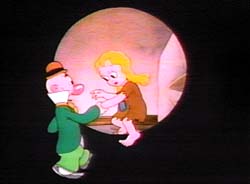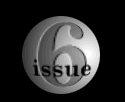|
Much of Disney's version of the "Three Little Pigs" is focused on the building of the houses. Avery, less interested in the virtues of the work ethic, minimizes this process in his take on the story. "Blitz Wolf" is an elaborate send-up of Hitler, who appears here as Avery's ubiquitous, comically pompous Wolf. The war, and catering to "our boys" who were fighting it, gives Avery the excuse to insert some surprisingly up-front sex gags. In one of his most blatant, the militant pig counters a very phallic missile with a copy of Esquire magazine. With a lewd smile, he holds up a cheesecake image, which causes the missile to retreat, bring back a group of its "friends," who then line up at stiff attention, emit a scream the viewer can't help but read as an orgasm, then fall limp back to Earth.

Princy (Egghead) and Cinderella leave the theater
screen in "Cinderella Meets Fella."
"Cinderella Meets Fella" (1938)/"Swing Shift Cinderella" (1943)
Egghead, a precursor of Elmer Fudd, is the "fella" of the title, and his co-star bears little resemblance to the sexpot created five years later for "Swing Shift Cinderella." She's small, more like a midget than a child, but feisty; desperate to locate her fairy godmother, she screams with a man's voice at the police: "GO GET HER, BOYS!" As in the other fairy-tale films, the godmother here is a lush, a fact well known to the police who are helping Cinderella find her ("Don't worry, lady, we'll search every beer joint in town!"). The opening frames offer a neat precis of Avery's style, starting with a formal, traditional image and sound (a fancy invitation to the ball, with appropriately courtly music) but quickly moving into the modern era (the invitation ends with an ad for "Sweeney's Drive-In" with a hot jazz background). "Cinderella Meets Fella" is also prescient: in an early, ironic variety of the much-loathed "product placement" of present-day cinema, Fella finds a note from his beloved that says "Dear Princy… went to a Warner Bros. show."

Cinderella's fairy godmother reels in the
Wolf in "Swing Shift Cinderella."
Five years later, Avery abandoned the brassy midget of "Cinderella Meets Fella" in favor of a more mature version. The title character in "Swing Shift Cinderella" is one of Avery's war-effort creations, a sexy pin-up girl come to life to show the American armed forces what they were fighting for. But she's no lifeless love doll -- besides her night job as a "Rosie the Riveter" type steel plant worker, she's an entertainer at the local nightclub. The fairy godmother doesn't dress her up for a prince but for her nightclub act, "Oh Wolfie!", a lurid display intended to drive the Wolf crazy. Cinderella, wielding a huge mallet, is as violent in her rejection of the Wolf as he is in his attempts to nail her. "Swing Shift Cinderella" is justly famous for a series of phallic sight gags by the Wolf, but the female characters are just as sexual and just as phallic. The fairy godmother is as randy as the Wolf, the object of her desires, and transforms herself into a kind of battering ram as she tries to land him. In one trick, she shoots a plunger at him, which then becomes a fishing rod that lets her reel him in.
page 3 of 4
 
|


